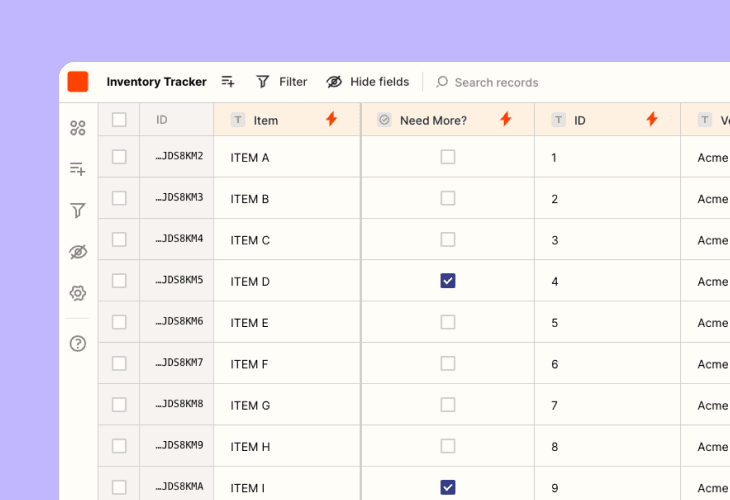Managing inventory effectively is a cornerstone of retail and e-commerce success. Tracking what’s in stock and where it’s located helps prevent missed sales opportunities and ensures that customer expectations are consistently met. A thoughtfully designed SKU tracking system plays a vital role in organizing inventory, optimizing stock levels, and identifying product trends that influence overall business growth.
This article explores the ins and outs of creating a system that improves accuracy and enhances sales efficiency.
What is SKU Tracking?
Stock Keeping Unit (SKU) tracking is the process of assigning and monitoring unique identifiers to distinguish products based on their attributes, such as color, size, and brand.

Image Source: Big Commerce
These codes make it easier to monitor product movement, identify trends in sales, and maintain up-to-date stock information across various locations or platforms.
An effective SKU tracking setup doesn’t just identify products. It also provides actionable insights about their performance, allowing businesses to make informed decisions about purchasing, stocking, and marketing efforts.
Whether managing a single storefront, a sprawling warehouse, or a digital marketplace, this approach simplifies operations and improves results.
Why Every Business Needs an SKU Tracking System?
Implementing a tracking system for SKUs is essential to achieve accuracy in inventory-related tasks.

Errors in manually handled processes can lead to overstocked shelves, shortages, or misallocated resources—all of which negatively impact revenue and customer satisfaction. Here are some advantages of setting up such a system:
1. Boosted Inventory Accuracy
- Automated solutions help prevent mistakes by recording updates in real time whenever items are scanned or moved.
- Data reconciliation becomes faster and much more reliable, cutting down on tedious manual checks.
2. Streamlined Stock Organization
- SKU tracking identifies which items sell quickly and which don’t, helping businesses avoid holding onto surplus or low-demand goods.
- Companies can maintain a balanced inventory by ordering just enough to satisfy customer needs without tying up resources in unnecessary stock.
3. Enhanced Sales and Customer Satisfaction
- By focusing on highly sought-after products identified through SKU sales data, businesses can adjust marketing strategies to drive revenue.
- Having products readily available fosters trust and increases the likelihood of repeat purchases.
4. Simplified Operations
- Centralized systems allow for the consolidation of data from different sales channels, giving users a complete view of stock levels.
- Automated warnings for items running low from tools like 42Signals prevent delays in reordering, saving both time and effort.
How to Build an Efficient SKU Tracking Process?
Creating a reliable system requires deliberate planning and smart use of tools. Follow these steps to ensure your approach is practical and effective:

Image Source: Startup Bros
1. Establish an Easy-to-Follow SKU Code Structure
Your codes need to be descriptive enough to tell team members what they represent at a glance while remaining simple enough to avoid confusion. For instance, instead of “T001,” which is vague, you might use “Shirt-LRG-RED” to convey the product’s type, size, and color.
Guidelines for Better Codes:
- Stick to a single format for consistency.
- Avoid symbols that could be misread by software or humans.
- Ensure no two products share the same identifier.
2. Adopt Barcode Scanning Tools
Barcodes work hand in hand with SKUs to simplify inventory tracking. A quick scan during processes like receiving shipments, fulfilling orders, or conducting audits ensures immediate updates to stock records.
Advantages of Barcodes:
- Faster processing compared to manual input.
- Reduced likelihood of human errors.
- Greater efficiency in managing incoming and outgoing inventory.
3. Use Feature-Packed Inventory Software
Choose tools that simplify SKU management by combining features such as real-time updates, detailed reporting, and integrations with other business systems. These platforms make keeping an eye on stock levels easier, whether it’s on a shop floor, in a warehouse, or across multiple online marketplaces.
Popular Software Choices:
- Shopify for sellers focusing on digital storefronts.
- Zoho Inventory for users who need cross-platform visibility.
- Fishbowl for those managing complex storage needs.
4. Connect to a POS System
A point-of-sale (POS) system with integrated SKU tracking automates inventory adjustments whenever sales occur. This eliminates the need for duplicate entries and provides up-to-the-minute information on stock levels.
Benefits of This Integration:
- Reduces manual workload by syncing sales and stock automatically.
- Makes it easier to analyze which items are performing well.
- Enables faster decision-making during restocking or promotions.
5. Perform Regular Stock Reviews
While automated tools reduce the chances of errors, occasional checks ensure everything stays accurate. Routine counts help spot issues like shrinkage or system glitches before they spiral into larger problems.
How SKU Insights Help You Make Smarter Stock Decisions?
SKU data provides a treasure trove of information that can help businesses refine how they manage stock. By studying patterns in this data, decision-makers can:
- Spot Buying Trends: Understand which products are popular during specific times of the year or among certain demographics.
- Move Old Stock: Implement discounts or special promotions for items that aren’t selling as expected.
- Prepare for Demand Spikes: Look at historical trends to predict upcoming busy periods and stock accordingly.
- Collaborate Effectively with Suppliers: Share data with suppliers to set up more precise order schedules and negotiate better terms.
How SKU Tracking Benefits Sales Performance?
Accurate tracking contributes directly to better customer experiences and higher sales. By ensuring products are readily available and marketing efforts focus on high-demand items, businesses can grow their revenue while building lasting customer loyalty.
Example of Success:
A mid-sized retailer struggling with mismanagement introduced a barcode-based SKU system paired with inventory tracking software. Within months, they achieved:
- A noticeable drop in stock errors.
- Faster processing of customer orders.
- A revenue increase due to better availability of in-demand products.
Conclusion
Creating a solid SKU tracking system may seem complicated, but the rewards far outweigh the initial setup effort. By blending barcode technology, smart software, and regular audits, businesses can keep inventory running smoothly, improve how they serve customers, and boost their overall sales performance.
Whether you’re handling a small-scale operation or managing multiple sales channels, these strategies can lay the foundation for steady growth.If you’re looking for a tool that helps with inventory management and product availability, check out 42Signals and schedule a free demo.







